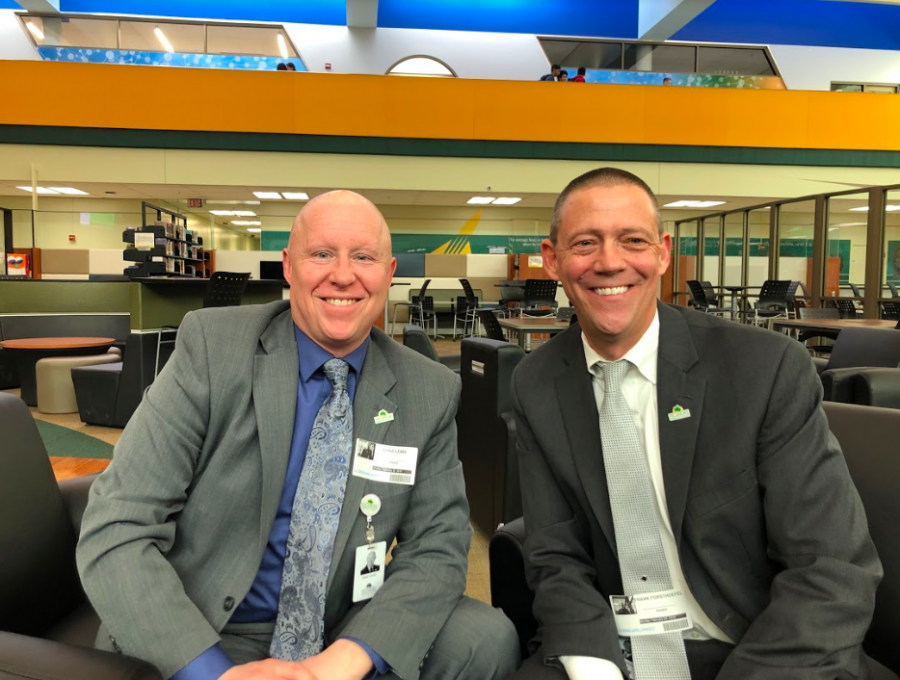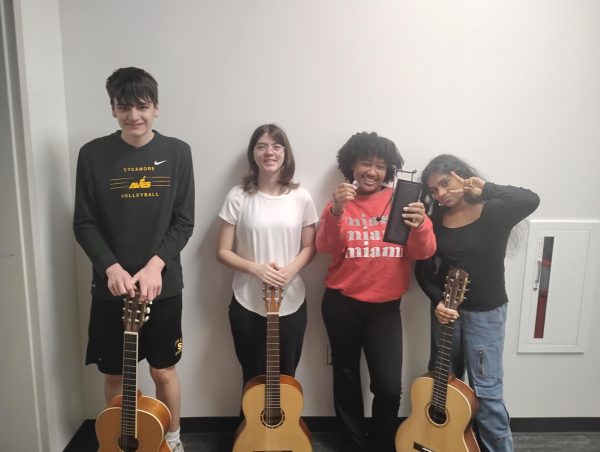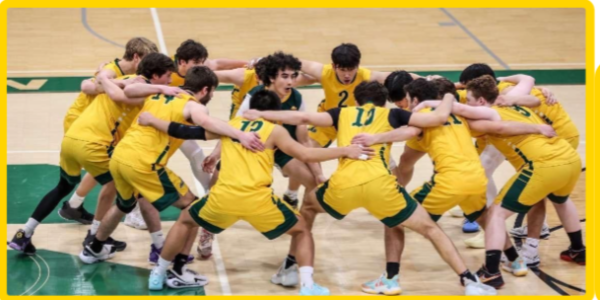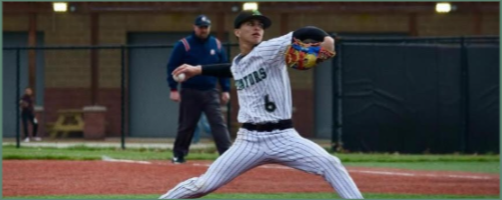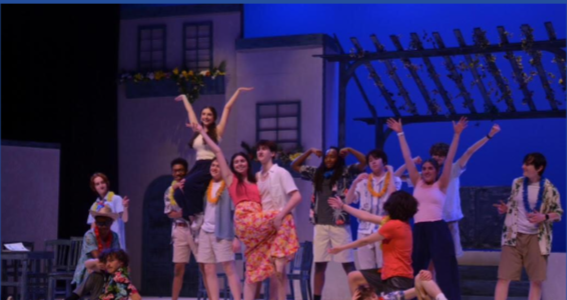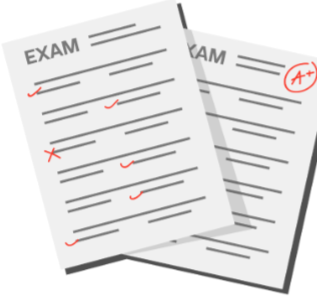Snow day decisions: behind the scenes
Q&A with Frank Forsthoefel and Chad Lewis
Pictured from left to right are Chad Lewis and Frank Forsthoefel
Frank Forsthoefel, Superintendent of Sycamore Community Schools
Chad Lewis, Director of Business and Student Operations of Sycamore Community Schools
Q: Firstly, what type of aspects, detail, etc. do you consider the weather in deciding delays and snow days?
F: Obviously, everything we do in the morning or even the night before is based on student safety. If you’re talking about snow days or ice days, it’s really all about the road conditions–are we comfortable with putting 60 some plus buses out there. But there’s another factor that I think some people maybe don’t pay as close as attention to, and that’s teenage drivers. Most of our drivers at the high school have been driving two years or less, and my guess is they haven’t done a lot of driving on snow and ice. That’s a huge worry for Mr. Lewis and me, to have really inexperienced drivers driving on the roads trying to get to school if the roads are not good.
L: Road conditions are huge. To kind of give you a picture of what we do, communication usually starts between 2:30 and 3:30 in the morning, especially on one that started either in the late evening, early morning hours. We literally drive around as many of the communities as we can get to, and we have kind of our particular areas; we look at some that have a lot of hills or we try to spend a lot of time in some neighborhoods because even though some of the main roads may be addressed, some of the backside roads are not addressed. We try to look at every place that we think a teen driver might be and [whether] we feel comfortable putting them in in this situation, plus what’s the weather going to look like moving forward. If it looks like it’s going to continue to improve, then we can look at potential delay or maybe having school on time. But if it looks like it’s going to continue to deteriorate, it’s an easy decision at that point.
Q: Is there a general quantity of snowfall or windchill that is served as a guideline for cancellation?
F: No, there isn’t. We keep our vision pretty close on what’s going on on the roads because that’s the key factor for us. I think to Mr. Lewis has a point; I think the most recent delay we had was a perfect example of that. We called the delay right around 5 o’clock because it was pretty rough out there. So then we started to check again around 6:30 to see if we needed to close school, but the roads were getting better and better and we also knew that within the next hour, hour and a half from 6:30 on, that they were going to get better. We knew they were out treating the roads and we also knew that it changed to rain, and there was no anticipation of more yucky weather. So we knew that by eight o’clock, actually, it would be nine o’clock by the time you guys were getting ready to drive in here, things were going to be okay. That’s why we stuck with a delay.
Q: Is there anything that is considered for letting out school early?
F: Well, you saw Mr. Lewis’s reaction. We really want to avoid that, if at all possible, and I know we did that last year once. Here’s the reason for that: when you release school early for the high school kids, it’s not a big deal. [They]’re old enough and can get home [them]selves. But when you have five, six, seven-year-olds and put them on a bus, we don’t know where their parents are; they may be working. Even though we tell parents to make sure to have a plan, sometimes a very young child is dropped off by a bus and there’s nobody home. That’s a major worry for us; that’s why we try to avoid that, if at all possible.
Q: What goes on when one school is closed but not the others?
L: We actually had that this year, where the power went out at E. H. Greene; there was a massive power outage that started in the Montgomery area and as we started to get ready to make that decision, the power kept going out at different buildings throughout the district. We thought [to close] with the instability and the wind, and we ended up closing school that day. We were only going to close the buildings that were affected; at that time, it was E. H. Greene and the junior high. We started [closing], and I was so thankful that we decided to close the district because, within probably a 30 minute period, Mapledale went down, Montgomery Elementary went down, and then the junior high went back down. That included our bus compound, so we were four schools down and we were uncertain of [whether it would] take down other schools. If our school is down without power, we got to have people transporting food out of the coolers and out of the freezers to other buildings, and then when the power does come back, we have to make sure all the systems are running correctly. It’s a tricky situation, but we would close an individual school if there was just a problem with that school.
F: We’ve had other occasions at Greene, maybe one or two in the last four years, where we had to cancel Greene because of power. It’s an older building, things happen.
Q: A lot of students use the snow day calculator online to calculate whether there will be a snow day the next day. Are you familiar with this?
F: No, what is that? That’s interesting.
L: That’s funny.
F: Well, what I would say to that is that’s all kind of neat stuff, but our cities here, Montgomery, Blue Ash, Symmes Township, and Hamilton County, are all doing an amazing job on the roads. They have probably prevented a couple of extra snow days because of the work that they do, but they can only keep up with so much. A lot of this is the timing when it comes. The worst scenario for Mr. Lewis and I is when the snow starts coming, or the bad weather starts coming at 5 o’clock in the morning. We prefer it come overnight; that way, we’re better prepared to make a decision. Because if it’s coming right when we have to make a decision or right when we start the day, it makes it really hard for us.
Q: For “cold days”, is your main concern the younger children waiting at the bus stops?
F: It’s all kids. We actually have a chart that we look at. We look a lot of wind chill and the impact of people standing outside for a certain length of time, with horrific wind chills. And then it becomes the health and safety issue.
L: If you go onto the National Weather Service website and click on the wind chill chart, it pulls up a chart and shows you if the temperature is supposed to be “this” and the wind is blowing at “this” miles per hour. It’ll tell you many things, such as “in ten minutes you could get frostbite”. So we look at all that and try to make good decisions based on National Weather Service data, not based on whether or not I think it’s too cold or [Mr. Forsthoefel] thinks its too cold; it’s really what’s the raw data, what does the data tell us, and the exposure. Even if we think it’s ok, if one kid ends up harmed, it’s a bad decision. We feel that way, and we think about every single kid because it is inconvenient for parents to make a decision late, to do something different with their kids for a day. We feel that and our hearts go out to those families, but if we ever feel like we’re putting a kid in danger or we might put a kid in danger, we will make the decision to close in a heartbeat because it’s better than taking a risk.
Q: So is your main source of information from the national weather service data?
L: That’s typically where we get most of the information, but certainly [Mr. Forsthoefel] and I both enjoy to tweet at different weather people and get their input, and we’ve done that a couple of times. We have a sycamore alumnus that does weather, Scott Dimmich.
F: I think the best example of that is when we early released last year. We actually physically talked to those people and called them, just to get an idea on the timing of when this stuff was coming. We don’t do that a lot, but when you have to make a decision on releasing kids early, you want to get as much information and data as you can. We talked to Scott Dimich and one of our people talked to Randy Richo on Channel 5 as well. They’re experts at weather while we’re not.
Q: Have you ever had complaints from parents or others regarding your decisions?
F: Yes. not too many, though.
L: [The complaints are] usually the inconvenience factor more than “this was a really bad decision”. Most of the parents that I see are very thankful when we made the decision, and it can be a tough call. The ones where we’re making the worst decision, in my opinion, is when we have to make a decision to close school based on the forecast, and the snow hasn’t fallen yet. That’s tough to make a call because all it takes is a little change with wind and direction and next thing you know, the storm passed you and you’re closed but there’s no snow on the ground. I know the kids wouldn’t be upset, though.
F: I mean, it’s a bad look. If we would call school with nothing flying, we would just be giving kids a day off when we wouldn’t need to. Those are hard decision to make. But I think Mr. Lewis is right; I think our parents and community understand why we make these decisions, and it’s in the interest of safety. I haven’t gotten a complaint in the past three years, and I think we get it right most of the times. I hope we get it right with the students because you guys always like a snow day, or two, or three.
Q: Do you consider the factor of the required amount of school days, and how does that play into your decision?
F: Well, that’s changed. Up until four or five years ago, we were given five [snow] days. [We] no longer are restricted to that, and it’s all about how many hours [we]’re in session–there’s a minimum number of hours–but we far exceed that. So we don’t have to worry about being limited to five days, although 99% of the years we don’t get to five. No, we don’t figure that in; our overarching factor is safety. If we still have the five and we went above the five, we would figure how to make it up, but we’re not going to put any kid at risk in order to do that.
Q: The delays used to be 90 minutes, but it has since changed to two hours. What prompted this change?
L: I hate to say it, but the easiest answer is math. People really struggle with what a 90-minute delay means, and for us, the extra 30 minutes does buy us a little more time to assess the road conditions and make decisions. We really don’t like to have to call a delay and then close. If there’s a potential that we might close, we would rather look at it on the merits of what we see on the road and make the decision to close versus starting with a delay. Parents get out there and make their arrangements, and then all of a sudden, we close. You’ll notice we’ve had very few delays the last probably 40 years that I can remember–we might have one or two–if they are [delays] they simply stay that way. So math played a big factor in making a decision to go from 90 to two hours, but we still have to explain to people, like what time will my bus come off. If it normally comes at 6:45, just add two hours so it’s 8:45. I listen to our District Personnel have those conversations numerous times the other day, because I think it’s just that they want to feel comfortable, they want to make sure. Like, I want to make sure that my kid is out there at the bus at the right time and we don’t miss anything, but if it’s two hours later it’s absolutely 2 hours after your bus start time. I think that when we went and got the 90 minutes, people really couldn’t figure out and very few districts do 90-minute delays.
F: When we do two hours, we cancel the morning kindergarten and morning preschool, because [the kindergarteners] would come in, be here for half an hour, and then go home. If [kindergarteners] are half time, we just say “you’re canceled for the day”.
Q: So is your general process first deciding on a delay, then after you assess all the conditions you decide whether to move it to a snow day?
F: No, I think our general idea is if the weather condition [is] bad enough, we’re going to close; we’re not going to start with a delay. Well, it really depends on the conditions at the time, what the forecast says and then how the roads are shaping up. If the roads are getting better and we think by the time that two hours is done they’re going to be fine, we’ll stick with the delay. But if we start with a delay and we keep watching it and things aren’t getting better or worse, then, unfortunately, we would have to change to a close. We don’t want to do that because it flips parents upside down, like “I was planning for a delay and now you close?” So if we can, we would rather just close and let [the parents] finish with their plans.
Your donation will support the student journalists of Sycamore High School. Your contribution will allow us to purchase equipment and cover our annual website hosting costs.


